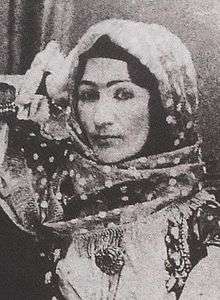Khurshidbanu Natavan
Khurshidbanu Natavan (Azerbaijani: Xurşidbanu Natəvan, born 15 August 1832, Shusha – 1 October 1897, Shusha) is considered one of the best lyrical poets of Azerbaijan[1] whose poems are in Persian and Azerbaijani. Daughter of Mahdiqoli Khan, the last ruler of the Karabakh khanate (1748–1822), Natavan was most notable for her lyrical ghazals.
Khurshidbanu Natavan | |
|---|---|
 Khurshidbanu Natavan | |
| Born | Xurşidbanu Natəvan August 15, 1832 Shusha, Elisabethpol Governorate, Caucasus Viceroyalty |
| Died | October 1, 1897 (aged 65) Caucasus Viceroyalty |
| Language | Azerbaijani Persian |
| Nationality | Azerbaijani |
| Citizenship | Karabakh |
| Genre | |
Life

Natavan was born on August 15, 1832 in Shusha, a town in present-day Nagorno-Karabakh. Being the only child in the family and descending from Panah Ali Khan, she was the only heir of the Karabakh khan, known to general public as the "daughter of the khan" (Azerbaijani: xan qızı). Her name Khurshid Banu (خورشیدبانو) is from Persian and means "Lady Sun". Her nom de plume Natavan (ناتوان) is also from Persian and means powerless.[2]
After her father's death, Natavan was closely engaged in philanthropy, promoting the social and cultural development of Karabakh. Among her famous deeds was a water main that was first laid down in Shusha in 1883, thus solving the water problem of the townsfolk. The local Russian "Kavkaz" newspaper wrote at the time: "Khurshud Banu-Begum left an eternal mark in the memories of the Shushavians and her glory will pass on from generation to generation".[3] The springs built by Natavan from famous Shusha white stones were called by the townsfolks "Natavan springs" and were also considered historical monuments under protection.
Natavan also did a lot for the development and popularization of the famous breed of Karabakh horses. In an international show in Paris in 1867 a Karabakh horse named Khan from Natavan's stud received a silver medal. In a second All-Russian exhibition in 1869 the Karabakh horse named Meymun won a silver medal, another stallion, Tokmak, won a bronze medal, while the third, Alyetmez, received a certificate and was made a producer stallion in Russian Imperial stud.
Natavan also founded and sponsored the first literary societies in Shusha and in the whole of Azerbaijan. One of them called Majlis-i Uns ("Society of Friends")[1] became especially popular and concentrated major poetic-intellectual forces of Karabakh of that time.[4]
Humanism, kindness, friendship and love were the main themes of Natavan's ghazals and ruba'yat. These sentimental romantic poems express the feelings and sufferings of a woman who was not happy in her family life and who lost her son. Many of these poems are used in folk songs nowadays.
Natavan died in 1897 in Shusha. As a sign of respect, people carried her coffin on their shoulders all the way from Shusha to Agdam, some 30 km north-east, where she was buried in a family burial vault.
Her sons Mehdigulu Khan and Mir Hasan Ağa Mir both left a collection of poems in Persian.
Fate of Natavan's monument in Shusha
In Shusha, Soviet-era monuments of Natavan[5] and other famous Karabakh Azeris including Hajibekov and Bulbul, which once decorated the central streets of Shusha, were severely damaged and dismantled. Polad Bulbuloghlu, then the Minister of Culture of Azerbaijan bought the bronze busts from Georgian scrap metal yard and transported them to Baku.[6]
Thomas de Waal who saw the monuments in Baku, wrote:
"I saw the three bronze heads, forlorn and pocked with bullets, lying in the courtyard of the headquarters of the Red Cross in the center of Baku: the poet Natevan, an earnest girl in a head scarf reading a book, missing a thumb; the composer Hajibekov, a bullet-ridden gentleman in double-breasted suit and broken spectacles; and Bul Bul, a famous singer with a serious domed bronze forehead".[7]
The monuments are now kept in the yard of the Azerbaijani Museum of Arts in Baku.[8][9]
References
- Naroditskaya, Inna (2000). "Azerbaijanian Female Musicians: Women's Voices Defying and Defining the Culture". Ethnomusicology. Ethnomusicology, Vol. 44, No. 2. 44 (2): 234–256. doi:10.2307/852531. JSTOR 852531.
- Nissman , David B. (1987) The Soviet Union and Iranian Azerbaijan:the use of nationalism for political penetration ,Westview Press ,ISBN 0813373182, p.84
- "Khurshud Banu-Begum". "Kavkaz" newspaper. August 29, 1873. p. 100.
- Abasova, L. V. et al. (eds.) (1992) Istoria azerbaijanskoi muziki Maarif, Baku, p. 116
- Natavan bust then and today Archived 2007-10-08 at the Wayback Machine
- Public Association for the "Protection of Right of Migrants and Internally Displaced Persons in Azerbaijan"
- de Waal, Thomas (2003). Black Garden: Armenia and Azerbaijan through Peace and War. p. 190.
- de Waal, Thomas (2003). Black Garden: Armenia and Azerbaijan Through Peace and War. New York: New York University Press. ISBN 0-8147-1945-7.
- "Глава 12. Шуша. Последняя цитадель". BBC News. 12 July 2005.
External links
![]()